SCION FR-S Test Drive since 2012
Comparative Test: Hyundai Veloster Turbo against SCION FR-S (Toyota GT 86)
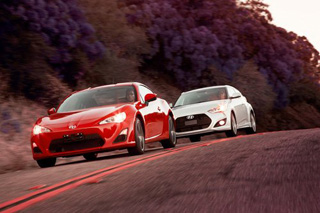 Fighters for the purity of the morals firmly facing the fact that few truths about sports cars are more obvious than the indisputable superiority of the rear drive. Point. This dogma was so unconditionally accepted by the developers of SCION FR-S (American analogue of Toyota GT 86 and Subaru BRZ), that even the model name literally screams about it (Front-Rear, adopted in English abbreviation, meaning that the car has anterior engine location And the drive to the rear wheels of the translator).
Fighters for the purity of the morals firmly facing the fact that few truths about sports cars are more obvious than the indisputable superiority of the rear drive. Point. This dogma was so unconditionally accepted by the developers of SCION FR-S (American analogue of Toyota GT 86 and Subaru BRZ), that even the model name literally screams about it (Front-Rear, adopted in English abbreviation, meaning that the car has anterior engine location And the drive to the rear wheels of the translator). But here the front-wheel drive Hyundai Veloster Turbo appears and bypassing it on the slalom. Yes, 109.4 km / h against 107.5 km / h at Scion.
I propose to make a small step back. A more obvious competitor to SCION FR-S at Hyundai is a rear-wheel drive Genesis Coupe ... but wait! Veloster Turbo, which we tested, costs $ 25,320 and produces 201 hp, which is practically identical to the FR-S parameters (our FR-S is worth $ 24,930 and issues 200 hp). If you close your eyes to obvious inconsistencies in the number of doors and the location of the drive axis, it will be very interesting comparison. Let's see how it looks in the real world.
Difference at Tempe
Veloster Turbo is relatively easy, only 1,320 kg, the suspension is tough, but in moderation. The reactions and responsiveness of Veloster Turbo when driving along a winding road on the so-called inertial speed in a good pace, but not so fast so that you should drop the speed before turning to hint at outstanding abilities, if you are interested in higher speeds and even more freight tracks.
But, unfortunately, the hints did not justify these herself, because it cost us a little more pressing the accelerator pedal, and the suspension stopped cope with the task. If you enter the turn, as I want, there is a feeling of something foreign in the chain, the road driver arises, as if the Kumho Solus KH25 215/40 rubber is too soft, or the suspension sleeves are overfilled. And the steering wheel, fast in the center, loses its elasticity, if you unscrew it until it stops. You will try to set gas at the outlet of the turn, and one of the wheels veloster begins to slip, because it does not have a differential friction, although it clearly needs it.
The more aggressive you drive the machine, the more Veloster Turbo annoys. And his quite decent grip here has nothing to do with it. The thing is how he behaves on the usual, far from the ideal, the road. Even in the city feature there is an increased sensitivity of the rear suspension to the irregularities, and if the rear wheel falls into the injection wheel in the center of rotation, the wheel will break away from the ground of centimeters by 8-10. When braking on the uneven surface of the suspension behaves as if it is not loaded enough. Therefore, nothing surprising in the comments, such as the car seems unfinished and the suspension is terrible we do not find.
Pottleness
After hitting the miniature FR-S salon after the control of Veloster, immediately note that the SCION seats are set below, with more efficient support, its body is noticeably tougher, and all controls are more mechanical. In turn it is much more accurate. FR-S brakes confident, the pedal location is perfect. Despite the fact that the veloster switching lever in Veloster is more higher, it seems some kind of toy in comparison with the SCION lever, giving a sense of control with something true mechanical. And even his some rudeness and periodic difficulties under the fourth drops are unable to spoil the pleasure that you get from this balanced unit.
Scion steering wheel is much sharper than Veloster, and much balanced is also. He does not hide anything from you, but it does not painfully respond to the imperfection of the road surface. On the ideal asphalt of our test track, it showed 0.90g lateral acceleration, which is much better than the results of Veloster (0.86g). Full stop at FR-S from a speed of 60 miles / hour (96 km / h) takes 35.9 meters, which again exceeds the result of the Veloster, although this small defeat can be written off to the modest characteristics of the Korean summer rubber.
But the main quality FR-S is still responsiveness. Even at the limit of the possibilities of Michelin Primacy HP 215/45, the machine remains the most assembled and communicative. It clearly makes it clear that and how to do to get the maximum of its abilities in any situation exceeding the permissible speed will lead to the drift of the front axle, but if at the same time carefully reset the speed and work a little gas, then you can easily restore equilibrium and clutch. And, honestly, in the case of FR-S it is incredibly fascinating. And unlike Veloster, this car allows the driver to use the full potential of the tires offered by the manufacturer.
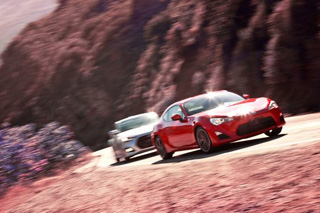 Mainly dignity
Mainly dignity We do not want to say that Veloster is all so bad. Its 1,6-liter turbocharged engine provides a flexible power range and so inconspicable turbine pickups that sometimes even forget that it is here. Put the gas leg, and the car smoothly accelerates to a pleasant speed until the tachometer is stored in the cut-off (6,750 rpm). At cruising speed, the sound of the motor is similar to whisper. Despite the solid 264 nm of the torque, which are served on the front axle, problems with handling does not occur.
We managed to fix 7.7 seconds to accelerate from scratch to 60 miles / hour (96 km / h), and the quotor was passed in 15.6 seconds (the speed on the finish of 143 km / h), although the usual acceleration is more dynamic than you can Assume looking at these numbers. In fact, the dynamics of the Turbo model is just what the basic veloster should have to have the basic veloster, especially if we consider the predicted ELE fuel consumption (10.8 liters per 100 km run around, 7.4 liters on the highway) Equally better than Scion (12.8 and 9.4 liters, respectively). From a speed of 96 km / h, it will stop 38.4 meters, which is not bad in itself, except for very quickly overheating tires that do not endure such exercises.
The car came to us for a test was equipped with only the Ultimate package worth $ 2,500, which, among other things, includes such utility, such as automatic headlights, the navigation system with the rear view camera and obstacle detection sensors. Unfortunately, the devouring space also includes a devouring space above his head and a panoramic hatch that negatively affects the hardness of the body. But in any case, Veloster Turbo offers a much richer list of options, rather than the Spartan FR-S.
Transformations of lists of options
Just as Veloster's speech on slalom, says yes, but, the same can be said about the behavior of the FR-S on the drag stripe. From zero to hundreds of FR-S accelerates in 6.6 seconds, which is almost for a second faster than Veloster, and he takes 14.9 seconds in 14.9 seconds, accepted at the finish to 149 km / h. Such a difference in the results can be easily recorded by 80 extra kg Veloster, which, in principle, does not contradict reality. But the real test on the ordinary road with many violants and turns has shown that their difference in the ability to accelerate between turns is not so noticeable.
Torque in this is plays only a minor role. With Veloster, it is, and in FR-S, he, let's say, there is, albeit with a small pit in the middle of the range. To get a maximum of torque from FR-S, you need to promote the motor up to 5,000 and sharply throw a clutch, while having to catch the ass. The wheels heated by such a start continue to scroll and during the transition from the first to the second, but the inline four-cylinder two-liter oppositor is not lost at such an appeal, which avoids the failure in the torque. Any other start method on FR-S in order to achieve a better time on the quoter is absolutely irrelevant. The veloster, on the contrary, there are no problems with the burden, but there is a clutch, its only effective wheel is located not from the side of the machine, which does not allow it to carry out the right start and what in turn is reflected on the results of tests where it is necessary to sharply accelerate .
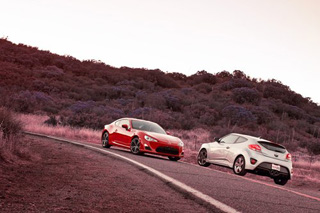 An additional torque in an average revolution range would definitely have a positive effect on the handling of the rear-wheel drive FR-S. The 204 Nm, issued by a 2-liter motor, is undoubtedly not enough for, say, a small disgrace on dry asphalt. This is a smoothly operating engine, and it is comfortable when the tachometer arrow flies around 7,400 revolutions (practically resting in the cut-off). It does not sound very good, and in the literal sense, since work on such high revs is quite noisy. Veloster, by the way, when accepted, also resembles a lawn mower, but on cruising speed it is practically not heard.
An additional torque in an average revolution range would definitely have a positive effect on the handling of the rear-wheel drive FR-S. The 204 Nm, issued by a 2-liter motor, is undoubtedly not enough for, say, a small disgrace on dry asphalt. This is a smoothly operating engine, and it is comfortable when the tachometer arrow flies around 7,400 revolutions (practically resting in the cut-off). It does not sound very good, and in the literal sense, since work on such high revs is quite noisy. Veloster, by the way, when accepted, also resembles a lawn mower, but on cruising speed it is practically not heard. All this is quite difficult to describe. If you play on a mountain serpentine in the catch-up, Veloster will lose more easy and more prompt FR-S, but in everyday life its ability to pull in the middle rumble is much more practical.
Sportiness against sports
From Veloster Turbo we came out disappointed. This is not the best sentence, if we are talking about a sports car, and all his sportiness is an aggressive style and unusual asymmetry. We want to believe that better tires and differential can significantly revive him, although it is more likely in the case of Veloster Turbo cheap multi-dimensions, carbon and other marketing moves.
SCION FR-S quickly acquires the status of the default choice when costs and fun are put in the chapter. Lowering to the fundamental truths, SCion demonstrated that the simple dynamics can be accessible, and thus made other automakers to recover.
Dogma on the unsurpasses of the rear drive the essence of the truth. SCION FR-S wins our comparative test.
short info
1st place: SCION FR-S
Dynamics and manageability. Successful success.
2nd place: Hyundai Veloster Turbo
More practicality, less interest.
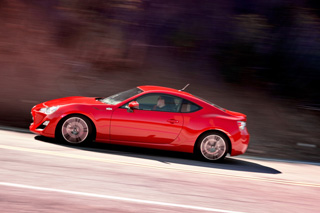
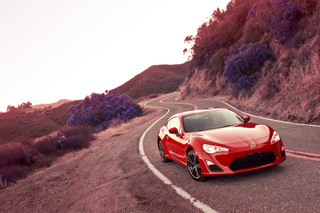
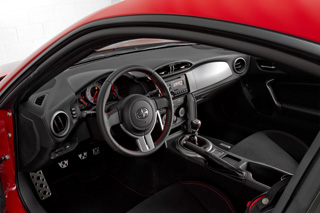
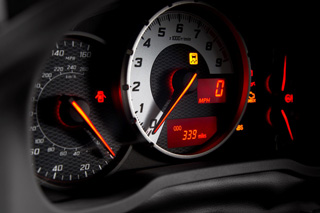
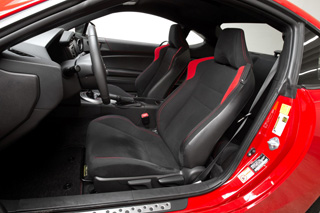
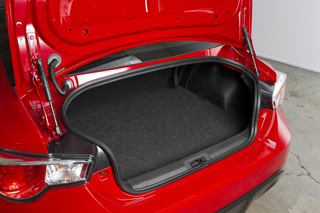
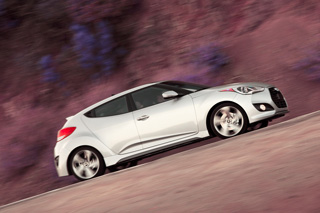
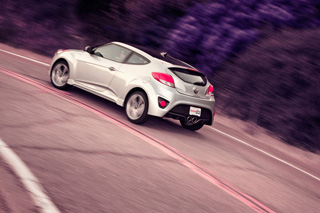
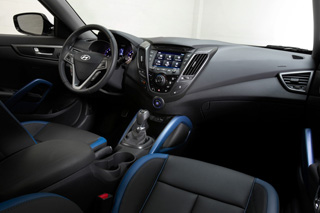
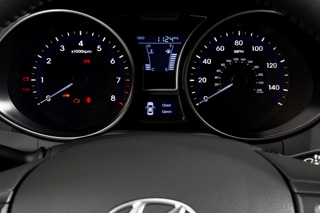
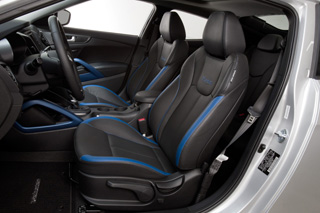
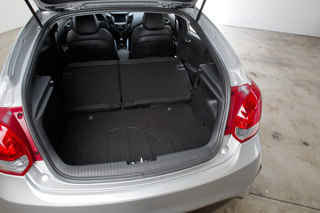
A source: Insideline.

.jpg)
.jpg)
.jpg)
.jpg)
.jpg)

